 Lamar Dodd Award 2004
Lamar Dodd Award 2004
David J. Benson, Distinguished Research Professor of Mathematics, is internationally recognized for important contributions to basic mathematical research, particularly in the areas of algebra and topology.
“He is quite unique in the way his work depends and uses the two different areas [algebra and topology] so very successfully. Such breadth and great depth at the same time is rare,” wrote Jonathan Alperin, mathematics professor at the University of Chicago.
In a broad sense, Dr. Benson’s research centers around the study of symmetry. He takes an abstract pattern of potential symmetries, called a group, and attempts to understand all the algebraic and topological objects that admit this abstract pattern as a collection of symmetries. If the object is linear in nature, this is called a representation. Cohomology is the glue between representations, and is also the link between the algebra and the topology.
His interests cover broad areas including finite group theory, representation theory, cohomology of groups, algebraic topology, commutative algebra and invariant theory. His work is at the forefront of a branch of algebra called cohomology of finite groups, which has applications in chemistry and physics. Dr. Benson has written four books related to subjects dealing with representation theory and cohomology with connections to algebraic topology. His two-volume series on representations and cohomology has become a standard reference tool. In addition, he is writing a book on music and mathematics based on the course he developed on that topic at UGA.
“In papers written jointly with [UGA mathematician] Jon Carlson, they laid the groundwork for a precise and practical geometric understanding of group cohomology via the use of cohomological varieties,” wrote Alejandro Adem, mathematics professor at the University of Wisconsin. “By combining techniques from algebraic geometry with representation theory, they developed easily applicable and powerful methods which have had a broad impact not only in group cohomology but which also have been applied successfully to difficult problems in topological transformation groups. Almost all recent progress in the field depends heavily on their work and it would be hard to overestimate the value of the Benson-Carlson techniques.”
Dr. Benson was awarded the London Mathematical Society’s 1993 Junior Whitehead Prize, a 1998 UGA Creative Research Medal, and a UGA Distinguished Research Professorship in 2000. Dr. Benson has received continuous funding from the National Science Foundation since 1994.
Previous Award
Distinguished Research Professor 2000


 Lamar Dodd Award 2007
Lamar Dodd Award 2007 Geert-Jan Boons, Distinguished Professor in biochemical sciences, is a world leader in glycoscience and synthetic chemistry. His discoveries have provided new insights into a variety of infectious and immunological processes, and many of the compounds developed in his laboratory are entering clinical evaluation. Boons is particularly well known for co-developing a vaccine that trains the immune system to recognize and attack tumors. In a mouse model that mimics human breast and pancreatic cancer—including those resistant to common treatments—this vaccine shrunk tumor size by an average of 80 percent. He is also widely recognized for developing one of the first methods to synthesize asymmetrical N-glycans, complex structures that are essential for normal cell function. This discovery will allow the scientific community to develop a better understanding of how complex carbohydrates function and how to fight against the diseases some of them cause.
Geert-Jan Boons, Distinguished Professor in biochemical sciences, is a world leader in glycoscience and synthetic chemistry. His discoveries have provided new insights into a variety of infectious and immunological processes, and many of the compounds developed in his laboratory are entering clinical evaluation. Boons is particularly well known for co-developing a vaccine that trains the immune system to recognize and attack tumors. In a mouse model that mimics human breast and pancreatic cancer—including those resistant to common treatments—this vaccine shrunk tumor size by an average of 80 percent. He is also widely recognized for developing one of the first methods to synthesize asymmetrical N-glycans, complex structures that are essential for normal cell function. This discovery will allow the scientific community to develop a better understanding of how complex carbohydrates function and how to fight against the diseases some of them cause.
 Lamar Dodd Award 2011
Lamar Dodd Award 2011 Lamar Dodd Award 2008
Lamar Dodd Award 2008 Lamar Dodd Award 2005
Lamar Dodd Award 2005 Lamar Dodd Award 2004
Lamar Dodd Award 2004
 Lamar Dodd Award 2002
Lamar Dodd Award 2002